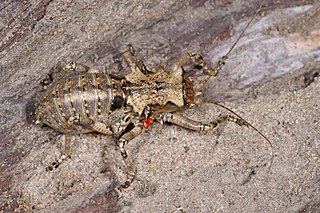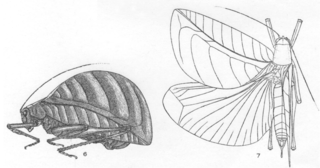
Hispaniola, or "The Spanish Island", is an island in the Caribbean that is part of the Greater Antilles. Hispaniola is the most populous island in the West Indies, and the region's second largest in area, after the main island of Cuba.

Insects in the family Tettigoniidae are commonly called katydids, or bush crickets. They have previously been known as "long-horned grasshoppers". More than 6,400 species are known. Part of the suborder Ensifera, the Tettigoniidae are the only extant (living) family in the superfamily Tettigonioidea.

Ensifera is a suborder of insects that includes the various types of crickets and their allies including: true crickets, camel crickets, bush crickets or katydids, grigs, weta and Cooloola monsters. This and the suborder Caelifera make up the order Orthoptera. Ensifera is believed to be a more ancient group than Caelifera, with its origins in the Carboniferous period, the split having occurred at the end of the Permian period. Unlike the Caelifera, the Ensifera contain numerous members that are partially carnivorous, feeding on other insects, as well as plants.

Pimenta is a genus of flowering plants in the myrtle family, Myrtaceae described as a genus in 1821. It is native to Central and South America, Mexico, and the West Indies.

The red-legged thrush is a species of bird in the family Turdidae. Native to the Caribbean, it is found in the Bahamas, Cayman Islands, Cuba, Dominica, Hispaniola and Puerto Rico. It formerly occurred on the Swan Islands, Honduras, but was extirpated there.
The Caribbean bioregion is a biogeographic region that includes the islands of the Caribbean Sea and nearby Atlantic islands, which share a fauna, flora and mycobiota distinct from surrounding bioregions.

Enyaliopsis is the largest genus in the subfamily Hetrodinae of the family Tettigoniidae. It is made up of 24 species found from east-central to southern Africa.
Panoploscelis is a genus of very large insects belonging to the true katydid tribe Eucocconotini, which is a subfamily of the katydids. Like the other members of the suborder Ensifera, Panoploscelis are part of the insect order Orthoptera, which also contains crickets, grasshoppers and locusts. Members of this genus are among the largest katydids of the Neotropics.

Nops is a genus of medium-sized South American, Central American, and Caribbean spiders in the family Caponiidae, first described by Alexander Macleay in 1839. It has a great richness on the Caribbean islands, and most mainland species are located in high proportion toward the Caribbean coast. It likely has a neotropical distribution, though most species of South America are known only from the coast of Colombia and Venezuela, including the islands of Aruba, Curaçao, Bonaire and Trinidad.

Mecopodinae, the long-legged katydids, are a subfamily of bush crickets found in western South America, sub-Saharan Africa, and Asia. In Asia, the distribution includes India, Indochina, Japan, the Philippines, and Malesia to Papua New Guinea and Australasia, including many Pacific islands.

The Copiphorini are a tribe of bush crickets or katydids in the family Tettigoniidae. Previously considered a subfamily, they are now placed in the subfamily Conocephalinae. Like some other members of Conocephalinae, they are known as coneheads, grasshopper-like insects with an extended, cone-shaped projection on their heads that juts forward in front of the base of the antennae.

Typophyllum is a genus of leaf-mimicking katydids belonging to the family Tettigoniidae.

Conocephalinae, meaning "conical head", is an Orthopteran subfamily in the family Tettigoniidae.

Agraeciini is a large tribe of bush crickets or katydids in the conehead subfamily, Conocephalinae.

Eulophophyllum is a genus of leaf mimicing bush crickets or katydids in the subfamily Phaneropterinae. It was originally circumscribed in 1922 by Morgan Hebard as a monospecific genus for the species E. thaumasium, but two new species were described and added to the genus in 2016.

The Hexacentrinae, are a subfamily of predatory bush crickets or katydids. The type genus is Hexacentrus, which are also known as balloon-winged katydids. The group has sometimes been treated as a tribe within Conocephalinae, which may be a sister group. Members of this subfamily have lobules on the male paraprocts. Most of them also have a flat, wide hind lobe of the pronotum.

Caedicia simplex is a species of bush cricket, native to New Zealand. It is also found in Australia.

Erechthis levyi, the blue-faced katydid or Eleuthera rhino katydid, is a katydid found in The Bahamas. Currently, it is described from specimens collected only on the island of Eleuthera. They are light brown in color throughout the body, but exhibit a bright turquoise-blue face and bear a prominent spine on the vertex of the head between the eyes, hence the common names. It is tentatively considered an endemic species to The Bahamas, as no specimens are recorded from Cuba or Hispaniola, where other Erechthis species occur. The species was named in honor of Leon Levy, a prominent Wall Street financier and philanthropist who spent much time on Eleuthera and was an avid admirer of the island's flora and natural beauty.

Barbitistes vicetinus, the Vicentine saw-tailed bush-cricket, is a species of katydids crickets in family Phaneropteridae endemic to Italy. The species was originally described by Antonio Galvagni and Paolo Fontana. It is found in vineyards and woody vegetation in the regions of Veneto and Trentino, in particular in the province of Vicenza. In 2016, it was listed as a Near Threatened species by the IUCN due to its restricted geographic range and extreme fluctuations in its population: its current extent of occurrence (EOO) is about 580 km2 (220 sq mi), and its area of occupancy (AOO) is between 50–100 km2 (19–39 sq mi). Formally described as a new species only in 1993, unexpected population outbreaks have severely impacted forests and crops in northern Italy in recent years.

















